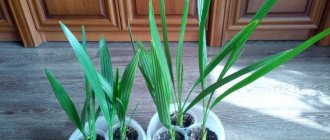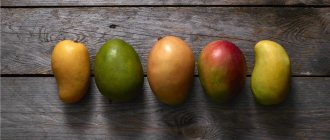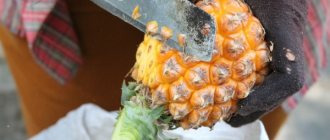Lychee is an exotic fruit native to the subtropics and tropics of China. Therefore, it also has other names: “fruit of love”, “paradise grapes”, “Chinese cherry”, “dragon eye”. Let's figure out what it is and how to grow lychee from a seed at home.
Description of fruit and tree
An evergreen plant, reaching 30 m in height in nature. The flowers are yellow or green in color, collected in umbrellas. Unfortunately, only 3 to 15 fruits reach adulthood, the rest fall off. Fruits ripen 4.5 months after flowering. The leaves are dark green shiny. Fruiting occurs after 4-10 years.
The fruit looks very interesting, similar to a hedgehog, but with soft needles and tubercles. Pink colour. The peel is easily separated from the pulp. The smell is reminiscent of citrus. The inside is sweet and tastes like grapes with notes of strawberry. One of the earliest crops, the harvest takes place at the end of May.
Interesting! The lychee tree is considered one of the most decorative and is widely used in landscape design.
What does the plant look like?
Lychee is a fairly tall tree, sometimes reaching a height of up to 30 meters. On the green crown, like toys on a Christmas tree, hang strange fruits: red “cones.” In fact, these are not cones at all, but small fruits in a dense red peel, under which the juicy pulp is hidden.
Lychee prefers to grow near bodies of water, on the sea coast, under the tropical sun. Here he is warm and humid, and there are no harsh winds. Japan, China, the Philippines, Cuba, and Hawaii can boast that lychee gardens grow on their territories.
Nutrients in fruits per 100 g of product
Lychee is rich in micro- and macroelements necessary for humans.
| Substance | Quantity in g |
| Water | 82 |
| Squirrels | 0,8 |
| Fats | 0,4 |
| Carbohydrates | 16,5 |
| Ascorbic acid | 0,072 |
| Calcium | 0,005 |
| Iron | 0,003 |
| magnesium | 0,01 |
| Phosphorus | 0,0030 |
| Potassium | 0,1 |
| sodium | 0,001 |
| Zinc | 0,00007 |
| Manganese | 0,00005 |
| Selenium | 0,00006 |
| Alimentary fiber | 1,5 |
| Vitamin K | 0, 00004 |
What are the benefits of lychee berry?
The beneficial properties of the exotic fruit have a pronounced beneficial effect on the body. Lychee when consumed in moderation:
- helps relieve constipation and regulates bowel function;
- restores the balance of vitamins and minerals in the body;
- has a pronounced beneficial effect on the skin and creates a rejuvenating effect;
- helps protect against viruses and colds;
- reduces unpleasant symptoms during inflammatory processes;
- improves blood composition and strengthens blood vessels.
Lychee can be used as an aphrodisiac - eating the fruit has a positive effect on the reproductive system of women and men.
What are the benefits of lychee berries for the female body?
Eating this unusual fruit is especially beneficial for the fair sex. First of all, lychee promotes weight loss in women. A low-calorie fruit on a diet helps remove accumulated toxins from the body, eliminates excess fluid and at the same time maintains the balance of vitamins.
When consumed regularly, lychee has an extremely positive effect on the skin. The epidermis becomes tightened and smooth, the first wrinkles and skin irritations disappear, and cellulite decreases. This effect can be achieved even if you simply eat the fruit, and when applied externally, lychee will bring results even faster.
The beneficial properties of the fruit are indispensable for genitourinary diseases. With the help of lychee, you can fight the symptoms of cystitis and urethritis; the fruit helps with thrush and inflammatory diseases of the endometrium.
The fruit is good for fighting inflammation
Lychee has a beneficial effect on the nervous system of women. Eating the fruit reduces stress, relieves anxiety and improves sleep quality.
Is it possible to lychee during pregnancy and breastfeeding?
Eating lychee during pregnancy is not prohibited, provided that there is no allergy to the product. The beneficial properties of the fruit can be very valuable for a woman; the fruits will help cope with toxicosis and swelling that occurs during pregnancy. Since the berries contain a large amount of vitamins, lychee can prevent the onset of vitamin deficiency.
Eating the fruit is also useful for preventing colds; the product strengthens the immune system. This is especially important for pregnant women, since even a common cold turns into a test; strong medications cannot be used during pregnancy.
Lychee fruits contain a lot of folic acid. Thus, the fruits become useful not only for the expectant mother, but also for the fetus. They contribute to the normal formation of organs and tissues in the baby.
But during lactation, it is better to remove tropical fruits from the diet until the baby is 3 months old. Although lychee enhances milk production and is therefore beneficial for a nursing mother, it can cause allergies in a child, like any exotic fruit.
Is it possible to give lychees to children?
Young children often suffer from allergies to tropical fruits; intolerance can also be caused by lychees. Therefore, it is recommended to offer fruit to a child only after reaching 3 years of age.
Exotic fruits should not be given to children - this can lead to allergies.
For the first time, the baby should be given only 1 small peeled berry to try. If no negative symptoms appear after a few hours, the fruit can be left in the diet and pampered with it from time to time.
Attention! Lychee has some strict contraindications. Before treating your small child to an unusual fruit, it is worth discussing this issue with your pediatrician.
Germination of seeds
This exotic fruit is one of the few that thrive among indoor flowers, although it only grows up to 2.5 m. The process can be seen in the video
| Growing conditions | Description |
| Temperature | Germination does not exceed 25°C, care does not exceed 35°C. |
| Soil composition | Expanded clay is placed on the bottom, with flower soil on top. The soil should be rich in vermicompost and breathable. |
| Watering | Moderate, as the soil dries out. |
Features of growing exotic fruit
With good home requirements. If you propagate a crop using seeds, it will take a very long time and rarely be of high quality. And the fruits will appear after more years.
Fresh seeds are taken for cultivation.
- They are planted in a small container with good soil and covered with available material. The container should be in a warm place.
- If all conditions are maintained, then the seeds germinate within a couple of weeks, after which the material with which they were covered is removed.
- After six months, three leaves are formed: two leaf plates form on two, and one on the last one. Active growth begins from the fifth to the ninth month.
- Fresh shoots appear from the fifth to the seventh.
- In autumn, growth dies down a little, and leaves stop appearing if the plant is annual.
- From the middle of the ninth month until the end of the second, the plant rests.
It will be interesting to read: Croton: propagation and care at home
How to care for lychee
With the help of air layering and grafting onto seedlings, propagation occurs much better. With the help of grafting, the root develops well.
Lighting
This culture needs plenty of light, so it is better to place containers with them near windows on the south or west sides. Do not forget that you need to protect plants from direct exposure to light rays. In winter, special lighting devices are used.
Air humidity
Air humidity should be high, since lychee grows actively during the rains.
Winter care
If you grow lychee in open ground, you should protect it from frost and strong winds, which can cause the plants to shed their leaves and crack the fruit.
If you plant several trees, make sure that there is a distance of at least six meters between them. And don't forget about fertilizers.
Flower buds can form in humid summer or winter at temperatures not lower than 10 degrees Celsius.
Watering
The plant should be provided with abundant watering during active growth, but wet stagnation should be avoided. During cold weather, watering is reduced. The soil needs to be moistened when its top layer begins to dry out.
Top dressing
If the plant is not yet four years old, then it should be fed twice a month. Minerals are used for this purpose. If the plant has already matured enough, then nutrition is rarely carried out.
If you grow lychees at home, prune the crown for the first couple of years so that it has a compact shape. This process will help get rid of damaged branches.
If you followed all the rules, then the tree will provide you with a rich and tasty harvest every year. Harvest immediately, because they quickly deteriorate.
Another article described: How to grow pineapple at home
Stages of growing from seeds
Subject to certain conditions, lychee grows well in our homes.
- The seed is removed from the purchased fruit.
- Wash the seed with warm water.
- They are planted immediately, since the seeds retain very little of their properties.
- Wrap in a damp cloth and leave for a week until a small root appears.
- Remove the husk from the pit that has become swollen.
- Prepare soil and containers for planting. The plant does not develop its root system well without special fungi. The best soil is the one taken from under old fruit plantings or you can buy such microorganisms at gardening centers.
- For greater effect, plant 2-3 seeds in one pot.
- The soil is moistened.
- Cover with covering material or polyethylene to create increased humidity.
- The container is placed next to the battery.
- Approximately 14 days after germination, the protection is removed.
- When the plant reaches a height above 20 cm and 5 leaves appear, it is transplanted into a larger pot for proper development of the root system.
Photo of growing lychee:
Important! During seed germination, the plantings are inspected. If the humidity is exceeded, ventilate; if the soil is dry, moisturize by spraying.
Reviews
– Of course, the lychee seed will germinate, wherever it goes, if the soil is fertile and the temperature is comfortable. For example, it has grown for me. Only it has never given color yet. I think it’s still too early; the tree was planted only five years ago. I am waiting!
Elena, Kaluga
– Lychees grow very slowly in the first years, I’m telling you this as an experienced gardener. It is necessary that the lychee be kept cool in winter, and in humid heat in summer, then buds can appear. And yet - if there are drafts in the house - forget about fruiting! This plant does not tolerate drafts. At first, due to inexperience, I ruined a good sprout. It also cannot tolerate swampy soil. I place a tray with high sides under the pot, and after watering I pour the water out of the tray. This must be done, otherwise the plant will die.
Vladimir, Saratov
– I experimented at one time, tried to germinate lychee seeds. But nothing worked for me, maybe the purchased fruits were of poor quality with dummies instead of live seeds? But my neighbor gave me a lychee tree for my birthday, already blooming. She nurtured him for fifteen years. And now I’m harvesting and my children really like it.
Natalya, Kazan
Lychee is both difficult and easy to grow. There is no difficulty in processing the stone. It will grow well in special soil. However, until the sprout gains strength, until the adult tree wants to please its owners with flowering and thank them for their care with a harvest, a decade will pass. Sometimes it takes even more time. But the patient gardener will still wait for fruiting, and then he will have his own real exotic plant with amazing fruits at home.
Health to you and your loved ones! Natalya Belokopytova.
Plant care
After germination, lychees are placed in a bright, warm place. The illumination of plants should be about 12 hours. If there is not enough of it in winter, additional illumination is necessary.
Let's look at the stages of caring for a lychee tree:
- Watering . The plant is checked periodically. Lychee does not like excess moisture and drought. If the humidity is high, watering should be stopped to prevent root rot. If the soil is dry, water.
- Spraying. If the air in the room is dry, the plant is sprayed with settled water, sometimes with the addition of fertilizer.
- First application of fertilizers. Produced 3 months after planting, then every 2 months.
- Fertilizing with mineral fertilizer . Carry out once a year, upon reaching the age of two, every 2 months.
- Formative pruning. They are carried out in the first and second years, giving a beautiful shape to the plant.
- Removing branches. If the tree is formed, then periodically remove dry branches and thin out.
- Ovaries. Cross pollination is used to obtain fruits.
Note! The dormant period of the plant is from September to May. At this time, its growth and the appearance of leaves slows down.
conclusions
- Lychee is a tasty and healthy exotic fruit that can be successfully grown at home.
- In order for the Chinese plum to bear fruit, it needs to be provided with bright lighting throughout the year; in the autumn-winter period it requires additional illumination with lamps up to 14 hours of daylight.
- To set flower buds, cool winter conditions are required (15-17°C).
- The process of planting a pineapple, like caring for a lychee tree, is simple - uniform watering, systematic feeding, timely replanting. This will ensure good development, flowering and fruiting of the Chinese plum.
Eating
Lychee fruits spoil very quickly, so they are cut and transported along with the bunch. The most nutrients and beneficial substances are found in fresh fruits. To reduce crop loss, they preserve, make jams and preserves, stew, fry, and dry.
Dried lychees are sold in other countries under the name "lychee nut" because the skin and pulp become hard when dried. Used in sauces, used as a ground seasoning.
Lychee is used to make mousses, cold soups, frozen, and used in the preparation of alcoholic and non-alcoholic drinks.
Is it possible to eat lychee berry seeds?
Despite the fact that fruit seeds have beneficial properties, you cannot eat them whole, raw or fried, as this can lead to poisoning. The seeds are only suitable for heat treatment in crushed form and for making powder. In minimal quantities it can be used for treatment and as a seasoning.
Fresh fruit seeds are poisonous, but powder from them can be beneficial
Diseases and pests
Lychee is quite resistant to diseases, but even here trees can be subject to various attacks.
- Root rot . Appears due to waterlogging. The plant dies. If the disease is not advanced, you can try to transplant the plant into another pot with a slightly moistened substrate, treating the roots with special fungicides.
- Shield. Remove insects with a damp cloth, then spray with an insecticide diluted with laundry soap. The seedlings are placed near the balcony door and the humidity around it is increased.
- Aphid. Damaged stems and leaves are cut off and sprayed with nettle infusion and soap.
- Spider mite. Wrap the plant in plastic to increase air humidity for 5 days. The tick cannot tolerate moisture. Then wipe the leaves on both sides with oil-containing preparations. If an ultraviolet lamp is available, the bottom of the sheet is illuminated. The tick dies from these rays.
- Thrips. Spraying to increase humidity, treatment with insecticide.
- Whitefly . The container with the plant is moved to a cool, dry place and sprayed with protective drugs.
- Mealybugs. When the pest appears, deposits similar to cotton wool appear on the leaves. To protect the fruit, the cotton wool is carefully removed, the pot is moved to a cooler and more humid place, or the moisture level around the crown is increased.
How to plant a seed
The best time for planting orange and lychee seeds is from March to July, when daylight hours and air temperatures are favorable for the development of this subtropical plant. But if you use lamp lighting and heating, you can plant lychee seeds at any time of the year. For planting, you must use a seed from a fruit you have just eaten, without allowing it to dry out. The pit should be large, dark and glossy, without defects. There is no need to split it or damage the top layer for faster germination. Read about treating tomato seeds before planting seedlings here.
How to germinate - preparation features
To speed up germination, it is recommended to soak newly collected lychee seeds in water for 7-10 days before planting so that they swell. It is best to place them between two layers of clean cotton cloth and keep it wet. The air temperature during the period of seed swelling should not be below +25°C. It is necessary to ensure that mold does not appear on the fabric and that there is no unpleasant odor.
It is better not to place soaked bones on the windowsill, especially if it is concrete or stone, to avoid overcooling them.
Selection of soil and containers for planting
While the seeds are swelling, it is necessary to prepare the soil and container for planting them. It is convenient to use a food-grade plastic tray 7-8 cm high as a container. The soil for seed germination needs to be light; high-moor peat with the addition of vermiculite works well. You can also use universal soil for decorative foliage plants, peat tablets for seedlings, and leaf humus, which must first be steamed to kill pests. You also need to prepare drainage - small-sized expanded clay or crushed polystyrene foam, broken brick, small crushed stone.
Rules and methods of planting
Planting pre-soaked seeds is done as follows:
- Place drainage in a 2-3 cm layer at the bottom of the container.
- A pre-prepared, slightly moistened substrate is poured on top.
- The seeds are laid flat on the surface of the soil at a distance of 5-7 cm from each other and from the walls of the vessel.
- Sprinkle the seeds with a 1 cm layer of soil and lightly compact them.
- Water the seeds with the water in which they were soaked, but not too much - the liquid should not protrude above the surface of the soil.
- Place the tray in a transparent plastic bag and place it in a warm, well-lit place, but not in direct sunlight.
Within 3-4 days, sprouts hatch from the seeds, and intensive seedling growth begins. In just a week they grow 12-15 cm and acquire a pair of double leaves. Young leaves of lychee are red-orange in color, gradually turning green. During the period of intensive growth of seedlings, it is necessary to untie the bag and open it more and more, gradually accustoming the plants to room air. When two pairs of double leaves grow, lychees are transplanted into small pots.
The size of the pots is selected so that the root system fills them almost completely.
Planting lychee seeds in peat tablets is done in the same way. Before use, they are watered with warm water to soak, and then the bone is placed flat in the recess and sprinkled with a thin layer of peat.
Use of fruits
The fruits of the plant are used for various purposes. Let's look at the main ones.
In official and folk medicine
Lychee fruits are widely used in folk medicine to treat diseases.
- Reducing and removing excess sugar from the body.
- Normalize the functioning of the gastrointestinal tract.
- Relieves symptoms of pneumonia, bronchitis, asthma, tuberculosis.
- Reduces the risk of cancer.
- Used for vitamin deficiency.
- Strengthens the body's immunity.
- Reduces cholesterol
- Strengthens the circulatory system.
- Provides concentration.
- Increases work capacity.
- Reduces inflammation of the tonsils.
- Removes excess fluid from the body.
- Treat atherosclerosis.
In cosmetology
Cosmetology cannot do without this fruit.
- Helps you lose weight, burns fat.
- Is a good antioxidant.
- Make a paste and decoction to protect the skin.
- Reducing swelling.
- Masks with a rejuvenating, moisturizing and nourishing effect.
- The strongest aphrodisiac.
What should be the pot for growing lychee?
Another important issue is the choice of container for growth. The lychee pot should not be too big. Drainage elements, such as pebbles, expanded clay or small pebbles, should be placed at the bottom of the container. This will protect the root system from rotting. Some gardeners recommend using walnut shells as drainage. The drainage should occupy approximately ¼ of the height of the pot. You should also check whether there are holes at the bottom of the container to drain excess liquid.
Contraindications for the use of lychee
Important! The fruit has almost no contraindications, but like any plant it has some effects on the body that have unpleasant consequences, especially due to overeating.
- Allergic reactions.
- Gout.
- With large consumption, the mucous membrane of the oral cavity becomes inflamed.
- Excess weight appears when you overeat sweet varieties of fruit.
- You can't eat the seeds, they are poisonous.
- Fruits with brown skin are not eaten so as not to cause stomach upset.
- Eating too much fruit causes gas formation.
Interesting! Lychee was considered the fruit of noble people. If ordinary peasants ate the fruit, they were severely punished.
During the harvest period, Thailand hosts the lychee festival, which consists of a festive procession, food and souvenir fair for fruit products. Various competitions are held, one of which is the selection of “Miss Lychee”.
Lychee at home
The home method involves the use of enclosed spaces: an apartment or a greenhouse. The easiest way to grow a lychee tree is from a seed.
You will need funds to create the desired home microclimate:
- humidifier;
- lamp or other source for local heating;
- sprayer;
- hygrometer (a device that records air humidity).
You will have to think about where to place the grown tree: the more spacious the room, the more expensive it is to provide a microclimate. The fruits will appear only in the third year. The harvest will not be as abundant as in our homeland. It may not appear at all. But the homemade exotic will delight you with just its appearance.
How to choose lychees to buy
To grow an exotic fruit, you need to get its seeds. But you need to do this for your own benefit. Lychee seeds are not sold in seed departments, but the fruit germinates from seeds taken from fruits purchased in a regular supermarket. When choosing lychees, you should pay attention to the color of the fruit, which should be pink. If it is brown or yellow, the fruit will be overripe or underripe.
Lychees are inspected for stains, cracks and mold. The ripe fruit has elasticity. The smell is fresh and pleasant. Fruits that have been left in the store smell of a sweet aroma.
Types and varieties
Breeders have developed many varieties and hybrids of lychee, but this crop is widely grown only in Asia. The most famous cultivars of the plant are:
- Green drooping is a tree with light green leaves, the fruit of which has a barely noticeable green stripe. The fruits do not lose their freshness and taste even three days after peeling them;
- Glutinous rice balls - the fruits of this variety have dense and sweet pulp with a taste of honey, they have a red skin without tubercles, and the seed is much smaller than that of fruits of other varieties, or there is none at all;
- Sweet osmanthus is a variety with sweet fruits that have the smell of osmanthus, in a bright red and very bumpy skin;
- Green Yatu - this variety has a fruit skin covered with dark green specks;
- Blackleaf is an early-ripening variety with fleshy fruits, the peel of which secretes a juice similar to red ink;
- May red is the earliest variety, the fruits of which are harvested in May;
- Concubine's Smile is the oldest early ripening variety. The fruits and peel of the plant secrete red juice.
In the photo: Lychee berries are a healthy fruit
Restrictions and contraindications
For some diseases, lychee consumption is not recommended. The list of contraindications includes:
- individual allergy to fruits;
- pancreatitis and gastric ulcer in the acute stage;
- gastritis with high acidity;
- gout.
The fruits should be consumed with caution if you have diabetes; the pulp contains a lot of natural sugars. The daily dosage of lychee for a healthy person should not exceed 200-300 g, otherwise abuse of the fruit can lead to the development of diarrhea and allergic reactions.
Fresh fruit should be evenly red, but not too dark
Rules for selection and storage
Choosing a fresh and tasty fruit in a store is quite simple, even if you have no experience of eating lychee:
- You need to buy fruits that are hard to the touch, weighty, and covered with a textured shell.
- The peel should not have dents, cracks or other damage.
- The color of the peel of a ripe fruit should be dark pink or red. If the skin of the berries is purple or has a brown tint, this means that the fruits are overripe and will no longer be able to please with a pleasant taste.
As for storing fruits, they need to be kept in plastic bags in the refrigerator; they retain their freshness and beneficial properties for 1-2 weeks. If you provide lychee with a humidity level of 85% and a temperature no higher than 2 °C, then the fruits can be stored for up to 10 weeks.
For long-term storage, lychee berries can be frozen, in which case they can retain their beneficial properties for up to 2 years. Dried fruits can be stored at room temperature for up to a year in dry glass jars.
The fruit can be kept in the refrigerator for about 2 weeks.
Benefits of lychee for weight loss
The exotic fruit contains a lot of fiber and diuretic components. Berries have low calorie content, but are very filling. Thanks to these properties, lychee is beneficial when consumed during a diet; the fruit suppresses appetite, removes excess fluid from the body, and helps get rid of toxins.
Advice! If you include tropical fruits in your diet, it will be easier to tolerate dietary restrictions. Berries will replace delicious, but forbidden desserts when losing weight.











